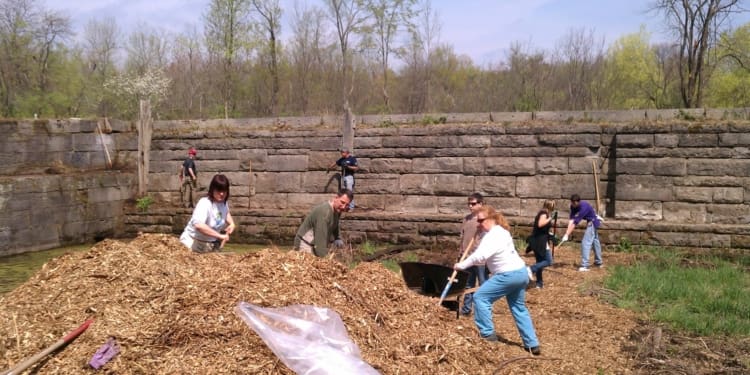Through a few serendipitous happenings, dozens of Shenendehowa High School students wound up at an abandoned lock in the woods along the Old Erie Canal this spring. They were not lost or wandering, but instead putting their minds to work on a unique problem.
This scene started when Chamber of Southern Saratoga County President, Peter Bardunias had gone to the site of the abandoned Lock 19 from the 1840s with Eric Hamilton of the Mohawk Towpath Byway to have a look at it. The area is at the end of Ferry Drive at the edge of the Vischer Ferry Nature Preserve. When they found the old lock hidden in the woods, Bardunias thought improving it would make a nice community project. “It had a very humble beginning … we also thought it would be kind of nice to clean it up,” said Bardunias. From there, he chatted about the prospects of expanding the clean-up of the site with Jim Wachala a senior project executive with Turner Construction. Soon, they put into place a design competition and opened it up to interested students at the high school. Eight teams of 10 students each were paired with mentors from Turner Construction and General Electric to build a mini-bridge or platform area from which to observe the historical site. Students had just six weeks to complete a design befitting the lock’s historical significance and at the same time make it accessible to visitors to the nature preserve. Categories for the design included orientation of the bridge, bridge design, historical presentation and marketing. The winning team will now see its vision implemented. “We were really surprised to get 80 students. And because it was a multi-faceted project we had a point person in social studies, one in history and one in business. … They were all very efficient with their time,” said Jean Lorch, academic administrator for science students at Shenendehowa High School. “The kids were very aware of the historical aspects. As far as the engineering aspects, I tried to encourage them to understand the design requirements and constraints as early as possible,” said Paul Kehoe, manager of the Engineering Review Board at GE Power & Water and mentor to the winning team. The winning design met criteria of all categories and offered visitors to the preserve to be “immersed in history,” according to Bardunias. “This really was a wonderful submission, what makes it interesting is a little bridge to go across the lock, it’s historically sensitive but not historically accurate because there was never a bridge there,” said Bardunias. He added that “modern safety features” were also incorporated into the winning design. Lorch, said that to be able to “engage the kids with real world engineers” was a great experience for everybody. She added that what the kids came back with as far as designs was more than anybody expected.
“It’s a great opportunity to show business partners what kids can really do,” she said.
Kehoe said the project was challenging for the students because of the time factors and because it was “very open-ended.” “This was a real life project where the students got to visit the historic site and visualize their bridge and site designs directly, while at the same time using the site survey and specified design requirements to create the bridge design and site plan,” he said. One of the biggest things that students got out of the project was “an appreciation for a multi-discipline project with engineering, construction, artistic and historical aspects” according to Kehoe. “Real life project experience will make their college educations more fruitful. I wish that I had an opportunity to participate in a project like this in high school or early in college,” he said.
On Wednesday, June 27, the Chamber held an awards ceremony for the students.
Best Overall Winners went to Team 1, mentored by Kehoe and including students Sarah Yang, Eric Wu, Sara Wong, Josh Elacqua, Angela Harper, Freddy Wang, Sean Walsh, Liangyu Tao and Erika McCarthy. Curtis Lumber is donating materials and Turner Construction is donating the construction components for the project, which should be completed by the end of the summer.
Students learning a Lock
Leave Comment



